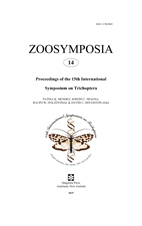Abstract
The Northeast Asian species of Kisaura Ross, 1956 (Philopotamidae) are re-examined and males and females of a new species from South Korea are described and illustrated. Kisaura coreana sp. nov. closely resembles K. tsudai (Botoşǎneanu, 1970) and K. hattorii (Kuhara, 1999) described from Japan, but distinguished from the latter two species by the shape of the spiniform processes of segment X in the male genitalia. Further, we conclude that K. kisoensis (Tsuda, 1939) is not a synonym of K. aurascens (Martynov, 1934) because of differences in the genitalia, which was also supported by molecular data. Also, the Neighbor Joining tree shows a clade including both the Japanese species K. nozakii (Kuhara, 1999) and K. borealis (Kuhara, 1999) with high bootstrap values, especially that for K. nozakii, collected from Hoshu Shiga, Kanzaki-gawa, Kazakoshi-dani (99% bootstrap value). This high value could reflect the possibility that they are the same species and just having differences based on geographic variation in morphological traits. These two species will be the subject of future studies.

